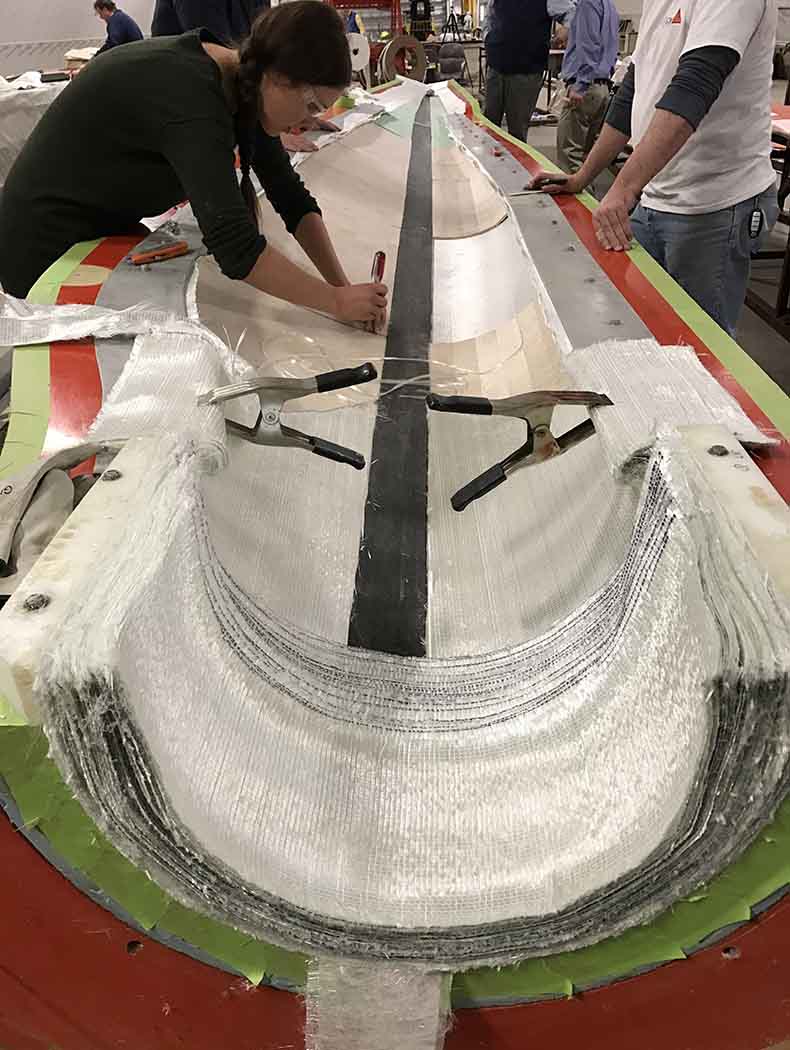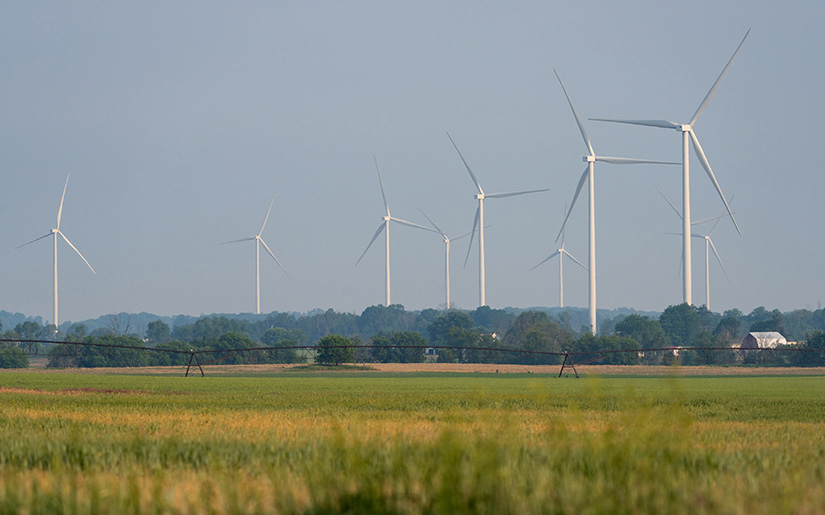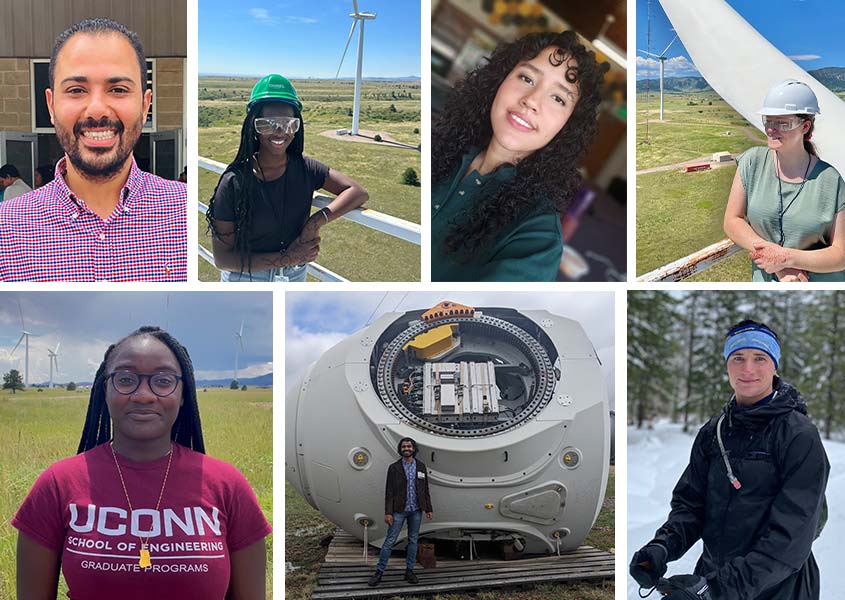The Leading Edge: August 2023 Wind Energy Newsletter
In this issue, NREL launches a new wind energy materials database, announces innovation awards, analyzes ordinances, interviews summer interns, and shares work on offshore wind energy in Maine—plus the latest events, news, and publications.
Upwind: Featured News
NREL Launches Database on Domestic Materials Used in Wind Energy Technologies

When developing wind energy technologies, it's helpful to know what alternatives exist and where they come from. Now, that information is available. Codeveloped by National Renewable Energy Laboratory (NREL) researchers, a new database provides a comprehensive compilation of the type, quantity, country of origin, significant uses, projected availability, and physical properties of materials used by wind and solar power technologies. The open-source Renewable Energy Materials Properties Database may help renewable energy stakeholders identify the type and quantity of materials needed to deploy facilities that can meet the growing demand for renewable energy in relation to global supply constraints.
The database, which is explained further in an accompanying summary report, was produced on behalf of the U.S. Department of Energy's (DOE's) Wind Energy Technologies Office (WETO) and Solar Energy Technologies Office in response to the requirements of the Energy Act of 2020 with contributions from experts at Oak Ridge National Laboratory, Lawrence Berkeley National Laboratory, Sandia National Laboratories, and Arizona State University.
NREL researchers also published two reports using the Renewable Energy Materials Properties Database. The Large Castings for Wind Turbines report quantifies the cast-iron wind turbine components needed to meet U.S. clean energy goals, and the Materials Used in U.S. Wind Energy Technologies: Quantities and Availability for Two Future Scenarios report provides more comprehensive analysis about the types of materials needed to support two future wind energy scenarios: steady growth in wind energy and accelerated growth to meet the Biden administration’s clean energy goals by 2035.
R&D 100 Awards Honor NREL Wind Energy Innovations
NREL wind energy researchers Jen King, Paul Fleming, and their team, on Aug. 23, 2023, received a research innovation R&D 100 Award from R&D World magazine. The award is for NREL’s Simulation and Emulation for Advanced Systems—the only software that simulates and validates energy transmission and distribution solutions across the buildings, transportation, and renewables sectors and the grid. This was one of two R&D 100 Awards NREL projects won. Wind program principaI investigator Anthony Lopez and his team were also recognized with an R&D 100 Award for NREL’s open-source Renewable Energy Potential model, which was originally seeded and developed with funding from WETO and provides unprecedented wind energy and solar power generation detail at scale to inform future clean energy systems.
Local Ordinances Play a Growing Role in Wind Farm Deployment
A new report from NREL is providing a clearer picture of how local zoning ordinances may affect potential renewable energy deployment. In an article in Nature Energy, NREL researchers identified an increasing number of local ordinances, such as noise levels, wind turbine heights, and setback distances from structures, roads, and property lines. Ordinances can help minimize impacts to the land and neighboring communities, setting a standard for sustainable and responsible development of renewable energy projects. At the same time, ordinances can limit the amount of land available for renewable energy projects, which, in turn, limits the amount of renewable energy available to decarbonize the U.S. energy system.
The highly detailed modeling and hyperlocal data used in this study have not been a part of previous research, and as a result, earlier studies have likely overestimated the amount of land available to renewable power plants. Therefore, previous studies likely underestimated the cost and challenges of achieving high levels of deployment. The results of the report indicate that local land use and community considerations play a significant role in U.S. decarbonization plans and should therefore be accurately reflected in modeling and analysis.

Behind the Blades: Staff Profile
Students Swap Classes for Hands-On Research as NREL Interns
Part of the largest intern cohort in laboratory history, 29 interns joined NREL's wind energy research efforts this summer through programs such as DOE's Science Undergraduate Laboratory Internship Program and the Research Participant Program. Before departing for their next adventure, several of the students shared what they worked on and reflected on their time at NREL.
A doctoral student studying offshore geotechnical engineering and civil engineering at Texas A&M University, Ahmed Radwan joined NREL researchers Amy Robertson and Matt Hall in their pursuit to advance floating offshore wind turbine technology this summer. Radwan worked to create a sophisticated model that can estimate the anchoring system for floating offshore wind turbines using different soil types and anchor options. "I've appreciated the valuable opportunity to collaborate with individuals from diverse disciplines working toward the common goal of developing offshore wind turbine systems," said Radwan. "The experience allowed me to learn extensively from my fellow group members, gain insights into various fields, and enhance my skills in organizing and coordinating work within a team."
Sita Nyame, who is working to earn her doctorate in environmental engineering from the University of Connecticut, joined NREL researchers Ulrike Egerer, Shashank Yellapantula, and Garrett Barter this summer. Nyame's project focused on using machine learning to predict dynamic wind loading on concentrating solar power collectors using real-world data. "In addition to the support of my mentors, I truly appreciated the barbeque events at Flatirons Campus. It created a great atmosphere to meet and network with people each week," said Nyame.
Samantha Paola White-Murillo is working to earn her master's degree in environmental management at Duke University. Mentored by NREL researcher Cris Hein, she evaluated the interaction between wind energy and wildlife in Latin American countries and aimed to identify ways NREL can help by sharing information and investigations. "Since the beginning of my internship, there have been so many opportunities to socialize, network, and meet professionals. This has allowed me to expand my knowledge in many disciplines," said Paola White-Murillo.
Working to earn her doctorate in civil engineering from the University of Massachusetts Amherst, Katherine Coughlan joined Matt Hall's team to work on projects primarily concerning software analysis of mooring systems for floating offshore wind energy. "Everyone at NREL has been so friendly and willing to help me with the internship as well as school-related research issues. I've learned new software, programs, and methodologies that will aid me in my academic career and beyond," said Coughlan.
Elizabeth Eyeson is working to earn her doctorate in computer science from the University of California Los Angeles. Under the mentorship of NREL researchers Paul Fleming and Misha Sinner, Eyeson worked to refine the FLOw Redirection and Induction in Steady State (FLORIS) model to better align with real-world data. This project will improve the quality of wake models that are important to address the impact of wakes on the efficiency and productivity of wind farms. "Getting exposure to work in sustainability was an exciting and different experience for me, especially because the research focus for my Ph.D. is healthcare and computation," said Eyeson. "Also, the culture of NREL is welcoming, creative, and passionate and made my internship an enjoyable and memorable experience!"
Starting in January 2023, Ryan Davies, who recently graduated from Macalester College with bachelor's degrees in physics and environmental studies, worked with NREL researcher Matt Hall to improve software that models the mooring systems for floating offshore wind farms. The software is used by researchers and developers around the world to optimize the future of this water-based form of renewable energy. "My favorite part of this internship is being able to find solutions to complex problems that will lead us to a more sustainable future," Davies said. "It is inspiring to work with so many experts, day in and day out, who are all working toward that common goal."
In May 2023, Aakash Manapat graduated from Vanderbilt University with bachelor's degrees in physics and chemistry. This fall, he will be starting a doctoral program in atmospheric science at the University of Washington. Under the mentorship of NREL researcher Caroline Draxl, Manapat investigated whether the combination of wind, wave, and solar energy resources would be sufficient to meet energy demands in Oahu, Hawaii, which could eliminate the island's need for fossil-fuel power plants. "I've really appreciated learning about the research environment at the national labs! So far, all my research has been in more conventional university environments, so it's been great to learn about new career paths I hadn't seen before," said Manapat.
Interested in doing an internship at NREL? Learn more about the opportunities available in wind energy for both undergraduate and graduate students.

On the Radar: Project Updates
Floating Offshore Wind Energy Development in the Gulf of Maine
The winds that blow over the Gulf of Maine are the most energetic in the U.S. Atlantic Ocean; that makes offshore wind energy a strong option for decarbonizing New England's energy supply. The northern New England fishing industry and its coastal communities depend greatly on the resources of this region, and those resources depend on the unique habitats located there.
NREL researchers, commissioned by the U.S. Department of the Interior’s Bureau of Ocean Energy Management, assessed the aspects and challenges of developing floating offshore wind energy in this region as general information for the citizens of Maine, Massachusetts, and New Hampshire and to inform decision makers and stakeholders. The final report summarizes the primary considerations for developing floating offshore wind energy, including the physical environment; technology; cost; electric power system; state and federal policy; stakeholder and tribal considerations; and supply chain.
Downwind: In Case You Missed It
Ukraine Fights To Build More Resilient, Renewable Energy System in Midst of War
In partnership with the U.S. Agency for International Development, NREL is supporting deployment of renewable-generation-based microgrids that will enable Ukraine to increase its energy independence and resilience by integrating more renewables into its energy mix. NREL teams will also be adding other renewable energy resource data for Ukraine to the RE Data Explorer platform that allows people around the world to assess their local renewable energy potential and inform renewable energy development decisions. Critically, wind resource data is anticipated to be added for Ukraine by early 2024.
Nine Remote and Island Communities To Improve Energy Resilience Through Energy Transitions Initiative Partnership Project
DOE's Energy Transitions Initiative Partnership Project provides remote and island communities across the country with a tailored team of energy resilience experts—including those at NREL—to help them target local energy goals. One of the program's nine newest communities—the Nooksack Tribe in Deming, Washington—will be exploring renewable and resilient energy technologies, including wind generators, to reduce frequent winter power outages that require emergency shelters.
Blowing In: Events, Media, and Publications
Join NREL and WETO researchers at upcoming events. Below are a few highlights.
Upcoming Event: NAWEA/WindTech 2023 Conference, Oct. 30–Nov. 1, 2023, Denver, Colorado
The full program is now available, along with registration for the conference and sign-ups for follow-up meetings, workshops, and the Graduate Student Symposium. Learn more and book your lodging on the conference website.
NREL in the News
Materials Needed for Wind and Solar Power Plants, Karl-W. Huelsenbeck, Clayton County Register, Aug. 16, 2023
Database Released To Quantify Materials Needed for Wind Energy Expansion, Howard Rhodes, EnergyPortal.eu, Aug. 16, 2023
Study Shows Municipal Setback Ordinances Limit Renewable Energy Potential in the US, Howard Rhodes, EnergyPortal.eu, Aug. 14, 2023
Building-Integrated Wind Turbines: A New Frontier in Green Technology, Staff Writer, EnergyPortal.eu, Aug. 11, 2023
'Setback' Ordinances Could Cut US Wind Potential by 87%, Solar by 38%: NREL, Emma Penrod, Utility Dive, Aug. 10, 2023
Local Zoning Ordinances Crucial to Renewables Deployment, Nina Korman, North American Windpower, Aug. 4, 2023
NREL Analysis Quantifies Impacts of Setback Ordinances on Land Available for Renewable Energy Deployment, NREL, Global Newswire, Aug. 3, 2023
NREL Study Finds Wind, Solar Setback Regs Proliferating, John Cropley, RTO Insider LLC, Aug. 3, 2023
In Turbulent Seas, Industry Experts Take Stock at US Offshore Wind 2023, Robin Coles, WorkBoat, July 19, 2023
New Prize To Propel Wind Turbine Materials Recycling, Staff Writer, Renewable Energy Magazine, July 18, 2023
Recent Publications
Atmospheric Science
Characterization of Wind Speed and Directional Shear at the AWAKEN Field Campaign Site, Journal of Renewable and Sustainable Energy (2023)
Grand Challenges
Grand Challenges in the Digitalisation of Wind Energy, Wind Energy Science (2023)
Tackling Grand Challenges in Wind Energy Through a Socio-Technical Perspective, Nature Energy (2023)
Modeling
A Comparison of Eight Optimization Methods Applied to a Wind Farm Layout Optimization Problem, Wind Energy Science (2023)
A New Coupling of a GPU-Resident Large-Eddy Simulation Code With a Multiphysics Wind Turbine Simulation Tool, Wind Energy (2023)
DQ Admittance Model Extraction for IBRs via Gaussian Pulse Excitation, IEEE Transactions on Power Systems (2023)
Mesh and Model Requirements for Capturing Deep-Stall Aerodynamics in Low-Mach-Number Flows, Journal of Turbulence (2023)
Operations and Maintenance
Wind Turbine Generator Reliability Analysis To Reduce Operations and Maintenance (O&M) Costs, EPRI White Paper (2023)
Main Bearing Replacement and Damage - A Field Data Study on 15 Gigawatts of Wind Energy Capacity, NREL Technical Report (2023)
Want More?
Subscribe to The Leading Edge newsletter, and explore the latest news and accomplishments in wind energy at NREL.
Share

